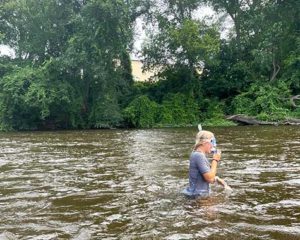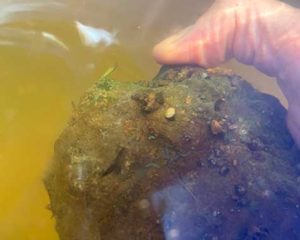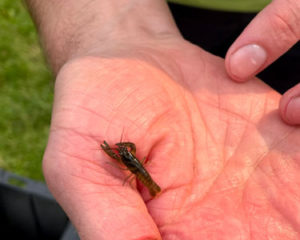
There are many ways to recreate in our beautiful waterways – kayaking, paddle boarding, swimming, snorkeling, and more. Snorkeling, while less common on the river, is a wonderful way to explore what lies beneath the surface.
HRWC partners with the Ann Arbor YMCA Youth Volunteer Corps (YVC) to hold a youth river snorkeling camp for middle and high school students each summer. But, anyone can do it!
“I never even thought about snorkeling in the river” – Snorkeling Camp Participant
Where do you go to river snorkel?
Anywhere it is safe to swim. Pick spots that don’t have a lot of current and where the depth matches your swimming ability and comfort level. Wear a life jacket—you can always keep your feet on the river bottom. The watershed has plenty of designated public swimming areas in the lakes that are part of the river system. Try the lakes at the Brighton, Pinckney, Island Lake or Proud Lake recreation areas for starters. There’s also swimming in Kent Lake at Kensington Metropark.
Is river snorkeling safe?

Yes! To ensure your safety, do not snorkel (or recreate) in the river within 48 hours of a rain event. Bacteria levels can increase from stormwater runoff. Never swim or snorkel alone. Always bring a lifejacket and sanitize your snorkel gear after every use! Sanitizing your snorkel gear not only helps you stay safe, but also prevents the spread of invasive species. HRWC has been teaching volunteers how to decontaminate monitoring equipment to prevent the spread of invasive species.
What you need:
To snorkel in the river, you will need a mask and a snorkel. A mask that covers your nose is preferable. These can be bought at your local sporting goods store or on Amazon.
You will also need water shoes or shoes you can get wet. The river is very rocky and unfortunately there could be a sharp metal object or broken glass on the bottom so you will not want to be barefoot.
A lifejacket is also recommended.
What you may see:

-Fish darting away from you.
-Freshwater sponges.
-Aquatic plants.
-Flecks of detritus whipping by you in the current.
-And many other exciting creatures.
Turning over rocks and examining them is a wonderful way to further your snorkeling exploration. Make sure to be gentle when handling the rocks and put them back where you found them. It is common to see mussels and other invertebrates holding onto the rocks.
River snorkeling is a fantastic way to explore the natural beauty around us and learn more about river ecology.
—Jessica Goldberg
Jessica Goldberg is HRWC’s Pure Oakland Water Marketing and Communications Intern. She’s a rising sophomore at the University of Michigan’s Ross School of Business. When not in Ann Arbor for school, she lives in the Rouge River watershed with her mom, dad, brother and dog.



